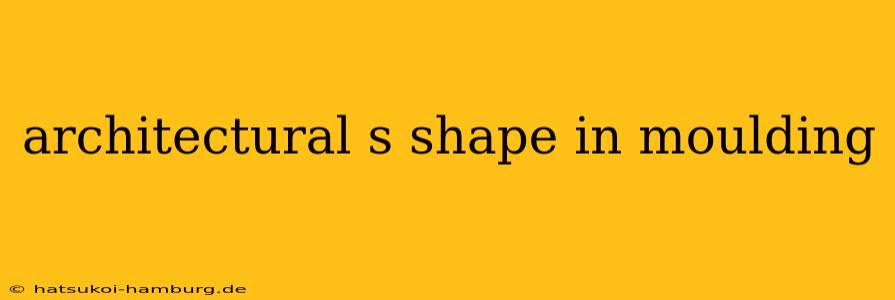Meta Description: Discover the captivating elegance of the S-curve in architectural molding. Explore its historical significance, design applications, and the timeless appeal that makes it a favorite among designers. Learn how to incorporate this graceful element into your own projects. (150 characters)
Introduction: A Timeless Classic
The graceful S-curve, a recurring motif in art and architecture, adds a touch of refined elegance to any space. In architectural molding, the S-curve, or serpentine curve, transcends mere decoration; it introduces movement and visual interest, drawing the eye and enhancing the overall aesthetic. This article delves into the history, applications, and enduring allure of the S-shaped molding in architectural design. From its subtle presence to its bold statement pieces, the S-curve in molding continues to inspire architects and designers.
A History of the S-Curve in Design
The S-curve's prevalence in design can be traced back to the Baroque and Rococo periods. These styles embraced asymmetry and organic forms, leading to the popularization of the sinuous S-shape in furniture, ornamentation, and architectural details. The curve's association with nature, specifically flowing water and plants, contributed to its association with beauty and grace. This natural association has ensured its continued relevance throughout design history.
Early Influences: Nature's Gentle Curve
Early examples can be seen in the ornate carvings of the Baroque period. The fluidity of the curve mirrored the elaborate details of the era, adding a dynamism often absent in stricter geometric styles. The graceful lines echoed nature's organic forms, creating a feeling of effortless elegance.
Rococo Refinement and Beyond:
The Rococo period further refined the use of the S-curve. It became a dominant feature in moldings, often incorporated into more complex patterns. This period saw intricate interplay between S-curves and other decorative elements, creating visually stunning results. The legacy continues to influence modern interpretations, demonstrating the enduring appeal of this classic design element.
Design Applications of S-Shaped Molding
The versatility of S-shaped molding allows its integration into diverse architectural styles and design schemes. From classical to contemporary, its adaptability showcases its enduring appeal. It can be used to frame doorways, windows, fireplaces, and even entire walls, creating a dramatic focal point or a subtle, elegant enhancement.
Framing Architectural Features:
The use of S-curve molding to frame architectural features elevates their presence. A simple doorway can transform into a grand entrance with strategically placed S-shaped molding. Similarly, windows can gain visual emphasis and a sense of sophisticated detail.
Creating Visual Interest:
Even small uses of S-shaped molding can create surprising visual interest. A subtly curved piece of crown molding can add a touch of elegance, while larger, bolder curves can become a design centerpiece.
Different Materials and Finishes:
S-curve molding is available in a wide variety of materials, including wood, plaster, polyurethane, and even metal. The material choice depends greatly on the style and design goals for the project. Matching finishes with surrounding architectural details creates cohesion and visual harmony.
How to Incorporate S-Shaped Molding
Integrating S-shaped molding effectively involves careful consideration of several factors, including the overall style of the space and the placement of the molding itself.
Choosing the Right Scale:
The scale of the S-curve should be proportionate to the size of the space and the surrounding architectural elements. Large, bold curves might overwhelm a small room, while subtle curves might be lost in a large, open space.
Placement and Positioning:
Strategic placement is essential for maximizing the visual impact of the S-curve. Consider the natural flow of the eye and position the molding to guide the viewer's gaze. The positioning relative to other architectural details is vital for visual harmony.
Combining with Other Design Elements:
Pairing S-curve molding with other complementary elements can elevate the overall aesthetic. Consider incorporating other organic shapes, like scrolls or floral motifs, to create a unified and cohesive design scheme.
Conclusion: A Continuing Legacy
The S-curve in architectural molding remains a timeless design element, its elegant form adding a touch of sophistication and movement to any space. Its historical significance and adaptability ensure its continued relevance in modern design. By understanding its history and application, designers can effectively incorporate this beautiful feature to enhance their projects, creating spaces that are both visually stunning and historically rich. The enduring appeal of the S-curve speaks to its inherent grace and timeless quality.
